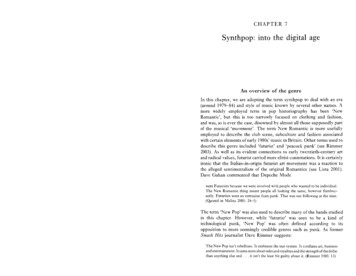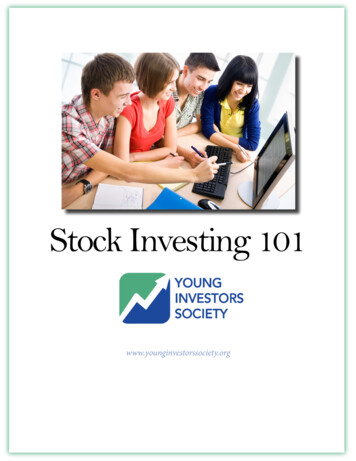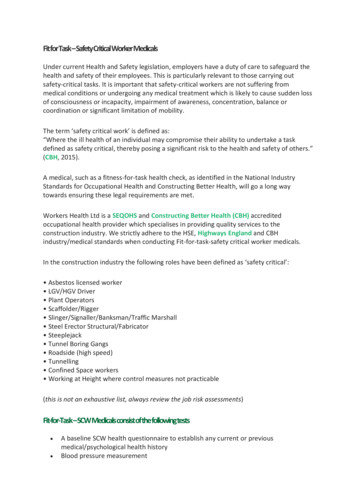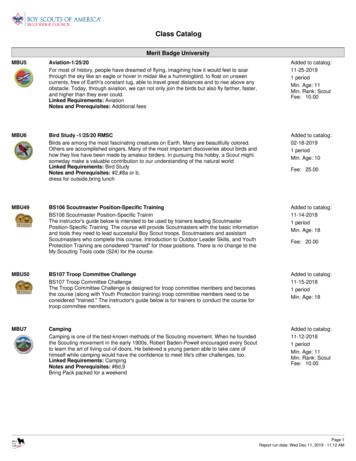
Transcription
118POPULAR MUSIC GENRES: AN INTRODUCTIONHebdige, D. (1987) Cut 'n' mix:Comedia.Identity and Caribbean MUSIc.S. (1988) Black Culture, White Youth: The Reggae Tradition/romJA toUK. London: Macmillan.CHAPTER 7Synthpop: into the digital ageMorrow, C (1999) StIr It Up: Reggae Album Cover Art. San Francisco:Chronicle Books.Potash, C (1997) Reggae, Rastafarians, Revolution: Jamaican Musicfrom Ska toDub. London: Music Sales Limited.Stolzoff, N. C (2000) Wake the Town and Tell the People: Dancehall Culture inJamaica. Durham, NC, and London: Duke University Press.Recommended listeningAntecedentsVarious (1989) The Liquidators: Join The Ska Train.Various (1998) Trojan Rocksteady Box Set. Trojan.Generic textsBig Youth (BurI).ing Spear (Alton (1993) Cry Tough. Heartbeat.King Skitt (1996) Reggae FIre Beat. Jamaican Gold.K wesi Johnson, Linton (1998) Linton Kwesi Johnson Independam Intavenshan:The Island Anthology. Island.Bob Marley and The Wailers (1972) Catch A Fire. Island.Rockers/Telstar.Pablo, Augustus (1976) King Tub y Aleets The RockersPerry, Lee (1997) Arkology. Island Jamaica.Max (1976) War Ina Babylon. Island.Steel Pulse (1978) Handsworth Revolution. Island.Toots and the Maytals (200]) S4-46 (Was lHy Number).U Roy (1971) Version Galore. Trojan.VariQus (1999) Trojan Lovers Box Set. Trojan.Various (2003)Reggae Sistas Box Set.An overview of the genreIn this chapter, we are adopting the term synthpop to deal with an era(around 1979-84) and style of music known by several other names. Amore widely employed term in pop historiography has been 'NewRomantic', but this is too narrowly focused on clothing and fashion,and was, as is ever the case, disowned by almost all those supposedly partof the musical 'movement'. The term New Romantic is more usefullyemployed to describe the club scene, subculture and fashion associatedwith certain elements ofearly 1980s' music in Britain. Other terms used todescribe this genre included 'futurist' and 'peacock punk' (see Rimmer2003). As well as its evident connections to early twentieth-century artand radical values, futurist carried more elitist connotations. It is certainlythat the Italian-in-origin futurist art movement was a reaction tothe alleged sentimentalism of the original Romantics (see ListaDave Gahan commented that Depeche Modewere Futurists because we were involved with people who wanted to be individual.The New Romantic thing meant people all looking the same, howeverandy. Futurists were an extension from punk. That was our following at the time.(Quoted in Malins 2001: 24-5)Subsequent generic developmentsBuju Banton (2003) Friends for Life.Lady Saw (1996) Give Aie A Reason. Diamond Rush.Sizzla (1997) Black Woman And Child. VP.Various Artists (1990) Hardcore. The Aiusic Works Dancehall Hits.Greensleeves.The term 'New Pop' was also used to describe many of the bands studiedin this chapter. However, while 'futurist' was seen to be a kind oftechnological punk, 'New Pop' was often defined according to itsopposition to more seemingly credible genres such as punk. As formerSmash Hits journalist Dave Rimmer suggests:The New Pop isn't rebellious. It embraces the star system. It conflates art, businessand entertainment. It cares more about sales and royalties and the strength ofthe dollarthan anvthim: else and.it isn't the least bit Iluiltv about it. (Rimmer 1985: lJ)
120POPULAR MUSIC GENRES: AN INTRODUCTIONThe term 'new musick' (most associated with the journalist Jon Sa vage) wasalso used to describe some of the music examined below. However, whereasour term synthpop crosses the high/low cultural divide, Savage specificallydeveloped the term 'new musick' to describe a post-punk move intoexperimentation, avant-gardism and a more synthetic and mythicallyEuropean sound (noted as early as November 1977 - see Savage 1977).Our term synthpop, while not 'value-free', can be employed totranscend many of the other terms' limitations. In particular, it cancover the wide terrain between groups such as Adam and the Ants, whomade little use of synthesiser technology but whose post-punk style wasboth resolutely pop and populist, and Cabaret Voltaire, who usedsynthesiser technology in an avant-garde 'industrial' style (and thereforeachieved high credibility and low sales). Somewhere between the two isNew Order, who despite massive success with their single Blue Monday,never fully capitalised on their popularity, at least partly due to theesoteric business practices of their label Factory Records.The influences of punk rock, glam rock, synthesiser technology, discoand the Germanic ambience of groups such as Can and Kraftwerk, and ofDavid Bowie in his 'Berlin' period (197&-7), were all crucial componentsin the construction of synthpop. By the height of the punk era, relativelycheap synthesisers and sequencers had infiltrated the pop landscapesufficiently for them to be considered a viable alternative to moretraditional instruments. Synthesiser-based music from artists as diverseas Jean-Michel Jarre, Donna Summer (LaDonna Andrea Gaines) andKraftwerk had made inroads into the British singles charts, and groupssuch as The Human League and Ultravox were releasing their first work.Tubeway Army's (Gary Webb, a.k.a. Gary Numan) Are 'Friends' Elec tric? was a chart-topping UK single in 1979 and gave synthpop its first'teen idol' (cf. Savage 1979).The more theatrical and flamboyant side of punk encouraged a smallgroup of London-based 'style victims' to congregate around mostly gayclubs such as Bangs, Louise's, Chaguarama's and the Global Village inthe late 1970s. In 1980, scene entrepreneurs and prime movers such asSteve Strange (Steven Harrington), Rusty Egan and Robert Elms beganto fashion their own 'Bowie Nights' or 'Heroes Nights' at Billy's and laterthe Blitz (Rimmer 1985: 30--1). This was a club-based scene based onrecordings. However, by the summer of 1980 performing groups such asSpandau Ballet and Duran Duran were beginning to tour and garnerpublicity in the British pop and newly-formed style press (magazines suchas The Face and i-D that looked as much at the newly termed 'lifestyle' asthey'did at its musical accompaniment).SYNTI-IPOP121By 1981, a host of acts connected to a synthpop sound had tasted chartsuccess, including Depeche Mode, Visage, Orchestral Manoeuvres in theDark, Ultra vox and the 'market leaders' Spandau Ballet and DuranDuran. These were followed by the likes of Japan, Soft Cell, CultureClub, Eurythmics, and Blancmange. As with any genre, the music wasdiverse but was characterised by a broad set of shared values thateschewed rock playing styles, rhythms and structures, and implied'feelings'. The rock aesthetic was replaced by synthetic textures oftenredolent of alienation, 'European-ness' and a robotic rigidity that was asmuch to do with the limitations of the new technology as any formulatedartistic credo. For Savage, the sound and credo was 'the reaction to thecardboard cut-out that punk had become. Glamour replaces grubbiness'(Savage 1995).By aroun9 1984, many of the biggest names had moved on fromsynthpop and its rather rigid musical constraints. Others simply enteredthe commercial pop mainstream. More sophisticated instruments andtechniques removed some of the amateurish 'rough edges' from the songsand sounds, and in the wider world of popular music there was somethingof a critical backlash against the flamboyance and self-conscious artifice ofthe style, which Savage named 'the New Authenticity' (Savage 1985).This can be seen in the success of performers such as Bruce Springsteenand Bryan Adams, and events such as 1985's Live Aid. Thanks to musicvideo and dedicated channels such as MTV, the synthpop soundalargely British phenomenon - did provide a platform for worldwidesuccess for some acts, many of whom, paradoxically, ended up asstadium-rock successes.For a style much vilified, synthpop gave the atrophying post-punkscene a much needed jolt. As well as popular ising new instruments andproduction techniques, it encouraged 'non-musicians' to create in muchthe same manner that punk had. Gary Numan referred to himself as littlemore than 'an arranger of noises' (Malins 2001: 5). Its strict dancefloorbeats can also be seen as a step towards the eventual partial hegemonydance in the 1990s, although many would argue that synthpop did noteschew melody or personality to the same extent in its quest for success.Historical roots and antecedentsAs indicated in our overview, the roots of synthpop were diverse. Theinitial musical impetus for synthesiser music lay in the avant-garde orneoclassical work of composers such as Walter (Wendy) Carlos, SteveReich and the musique concrete of Pierre Schaeffer, or from institutions
122POPULAR MUSIC GENRES: AN INTRODUCTIONsuch as the BBe. Within the popular music field, the synthesiser'sexclusivity and expense excluded it from all but a handful of artistsuntil the early 1970s. By the middle of that decade, synthesiser use wasinfiltrating mainstream pop. Many synthpop musicians drew upon thework of Roxy Music's Brian Eno, a truly ground-breaking conceptualartist more interested in ambience than chord progressions. The RoxyMusic influence also encompassed the clothing style of lead singer BryanFerry. Sequencers, featuring a programmable memory that could play back, mix sounds and adjust tempo, had also made their appearance onworks such as The Who's TIVho's Next and Pink Floyd's Dark Side Of TheIMoon. In particular, On The Run, from the latter work, can be seen as ablueprint for subsequent genres such as synthpop and techno. Drummachines and electronic drum kits had also begun to be employed inpop,ular music, in genres as diverse as funk (Sly and the Family Stone'sThere's A Riot Coin' On), progressive rock (Kingdom Come's Journey),and proto-techno (Suicide's eponymous debut album and Kraftwerk's1970s' output). The possibilities and limitations of all these new tech nologies at least partially determined the structure and feel of muchsynthpop.In many ways, synthpop's immediate predecessor punk rock was amajor influence on the genre, but only in the sense that synthpop was areaction to, rather than a continuation of, punk rock. Punk's DIYideology did not encompass the use of synthesising technology (a reactionagainst its dominance in progressive rock), preferring to believe that theplayed and untuned guitar was the most authentic 'voice' ofmusical alienation. Peter York would certainly agree, suggesting that thereasoning behind New Romantic's fetishism of synthesising technologywas as a reaction to the 'modern Luddism' and 'formalized primitivism' ofpunk rock, which was itself a reaction'the boring pretensions' ofkeyboard-based progressive rock (York 1980: 164). A furtherdifference between punk rock and synthpop was that musiciansin the latter field had little of the 'authenticist' snobbery of the rock world.Indeed, many revelled in the seemingly artificial nature of synthesisers,The Human League adopted a strict 'synthesisers only' rule in their earlydays to avoid 'musicians' taking control away from them (Rimmer IThe so-called foundations of popular music, be they jazz, blues, folk orsoul, had little influence upon the synthpop genre. Instead, criticallyderided forms such as disco and glam rock provided much of theblueprint for synthpop, summed up as using 'modern-sounding electro nic instruments to Dlav good old-fashioned pop songs' (Rimmer 1985:SYNTHPOP123these forms, synthpop shared an interest in accessibility, dance beatsand melody, filtered through the possibilities offered by new sounds andtextures. A figure such as David Bowie, one of very few musicians togarner both widespread artistic credibility and commercial fame in the1970s, was crucial to the synthpop scene, with musicians such as GaryNuman, Gary Kemp of Spandau Ballet, John Foxx (Dennis Leigh)Ultravox and Duran Duran's Nick Rhodes (Nicholas Bates) evidently inhis debt.If Bowie waS the principal British role model for synthpop, then thedebt owed to Kraftwerk cannot be overlooked. From avant-garde beginthe group honed and minimalised their sound by the time of theircommercial breakthrough with Autobahn in 1975. This album, along withTrans Europe Express and The Man Machine, alerted musicians to theopportunities made available by technologies that were very rudimentaryby later standards. In particular, Bowie's work on Low and Heroes adds asheen of visual appeal and accessibility to the somewhat forebodingappearance and delivery of Kraftwerk.The final major contribution to synthpop lay in the ground-breakingEuro-disco sound popularised most effectively by Donna Summer andher producers/writers Giorgio Moroder and Pete Bellotte. By fusing 'soulvocals with a backing track built upon a combination ofand traditional instruments (albeit played as though by machines),team of musicians operating in the unlikely setting of a studio in Munichachieved huge commercial and critical success with tracks such as J FeelLove. The rigid 4 : 4 drive of the disco beat fuelled most synthpop tracksand its huge legacy remains widespread to this day. More conventionalsoul/disco acts such as Chic also influenced synthpop. A track such asDuran Duran's Careless Memories is a classic hybrid of Euro-disco, newwave guitar pop and Bowie/Kraftwerk, topped off with the teen appealimagery and classic song structure and melody of commercial pop.Social and political contextThe synthpop scene occurred shortly after the transformation of punkrock into the more marketable 'new wave'. New wave still shared acommon set of values with its progenitor based around aggression,authenticity and the power of rock as an agent of social change. Inspring 1979, at the height of popularity for new wave, Britain returned theConservatives to power after a five-year absence, and in doing so electedBritain's first female Prime Minister, Margaret Thatcher. The effects ofConservative Party's shift to the right were soon seen with a marked
124SYNTHPOPPOPULAR MU
Dave Gahan commented that Depeche Mode . were Futurists because we were involved with people who wanted to be individual. The New Romantic thing meant people all looking the same, however andy. Futurists were an extension from punk. That was our following at the time. (Quoted in Malins 2001: 24-5)










